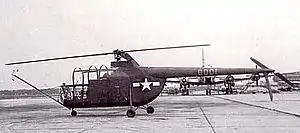Firestone XR-9
The Firestone XR-9, also known by the company designation Model 45, was a 1940s American experimental helicopter built by the Firestone Aircraft Company for the United States Army Air Forces. Only two (the military XR-9B and one civil example) were built.
| XR-9 | |
|---|---|
 | |
| Role | Utility helicopter |
| Manufacturer | Firestone Aircraft Company |
| First flight | March 1946 |
| Primary user | United States Army Air Forces |
| Number built | 2 |
Development
Originally developed by G & A Aircraft with the co-operation of the United States Army Air Forces' Air Technical Service Command, the G & A Model 45B (designated XR-9 Rotocycle by the Army)[1] was a design for a single-seat helicopter of pod-and-boom configuration.[2] It had a fixed tri-cycle landing gear and three-bladed main and tail rotors. Power would have been supplied by a 126 hp (94 kW) Avco Lycoming XO-290-5 engine.[3] The Model 45C (XR-9A) was the same helicopter with a two-bladed rotor. Neither of the two helicopters were built. G & A Aircraft was purchased by Firestone in 1943,[3] and was renamed the Firestone Aircraft Company in 1946.[4]
A revised two-seat design the revised Model 45C (or XR-9B) was built with a three-bladed main rotor and two-seat in tandem. The first aircraft procured by the Army Air Forces in 1946,[3] it was powered by an Avco Lycoming O-290-7 engine[3] and first flew in March of that year.
A civil version, the Model 45D was also built and flown, in anticipation of a postwar boom in aircraft sales.[3] This differed in having the two occupants side-by-side instead of tandem as in the 45C, and was equipped with a 150 horsepower (110 kW) Lycoming engine.[3] The prototype was demonstrated at the 1946 Cleveland National Air Races.[5] A four-seat Model 50, with twin tail rotors, was also projected,[3] but the predicted sales boom did not materialise, and Firestone closed its aircraft manufacturing division.[3]
Variants
- Model 45B
- Unbuilt single-seat helicopter with three-bladed rotor, Army designation XR-9.
- Model 45C
- Unbuilt single-seat helicopter with two-bladed rotor, Army designation XR-9A.
- Model 45C (revised)
- Tandem two-seat helicopter powered by an Avco Lycoming O-290-7 engine and two-bladed rotor, one built as the XR-9B, later re-designated the XH-9B.
- Model 45D
- Side-by-side two-seat helicopter for civil market, one built.
- Model 50.
- Four-seat version, not built.
- XR-9
- Army designation for the unbuilt Model 45B
- XR-9A
- Army designation for the unbuilt Model 45C
- XR-9B
- Army designation for the Model 45C (revised), later redesignated XH-9B
- XH-9B
- XR-9B re-designated in 1948.
Operators
Survivors
The sole Model 45D is in non-display storage at the Army Aviation Museum at Fort Rucker, Alabama. It is painted as an XR-9 46-001. The sole Model 45D has recently been refurbished and is now on display (without blades installed) at the Army Aviation Museum at Fort Rucker, Alabama
Specifications (XR-9B)
Data from Jane's all the World's Aircraft 1947,[6][7]
General characteristics
- Crew: 1
- Capacity: 1 pax
- Length: 27 ft 7 in (8.4 m)
- Height: 8 ft 6 in (2.6 m)
- Gross weight: 1,750 lb (794 kg)
- Fuel capacity: 25 US gal (21 imp gal; 95 L) 80 Octane fuel
- Powerplant: 1 × Lycoming O-290-7 4-cyl. horizontally-opposed air-cooled piston engine, 135 hp (101 kW)
- Main rotor diameter: 28 ft 0 in (8.53 m)
Performance
- Maximum speed: 100 mph (160 km/h, 87 kn)
- Cruise speed: 80 mph (130 km/h, 70 kn)
- Service ceiling: 10,000 ft (3,000 m)
- Rate of climb: 1,000 ft/min (5.1 m/s)
References
Notes
- "Short Hop Helicopter". Popular Science, April 1946.
- Andrade 1979, p. 171.
- Merriam 2002, p. 64
- Lambermont 1958
- <AAHS Journal, Winter 2003, p. 316.
- Bridgman, Leonard, ed. (1947). Jane's all the World's Aircraft 1947. London: Sampson Low, Marston & Co. pp. 230c=231c.
- The Illustrated Encyclopaedia of Aircraft. London: Orbis Publications.
Bibliography
- Andrade, John. U.S. Military Aircraft Designations and Serials since 1909. Hinckley, Leicastershire, UK: Midland Counties Publications, 1979. ISBN 0-904597-22-9.
- The Illustrated Encyclopedia of Aircraft (Part Work 1982–1985). London: Orbis Publishing, 1985.
- Lambermont, Paul Marcel. Helicopters and Autogyros of the World. London: Cassell and Company Ltd, 1958. ASIN B0000CJYOA.
- Merriam, Ray. World War II Journal #15: U.S. Warplanes of World War II, Volume 1. Bennington, Vermont: Merriam Press, 2002. ISBN 1-5763-8167-6.
External links
 Media related to Firestone XR-9 at Wikimedia Commons
Media related to Firestone XR-9 at Wikimedia Commons